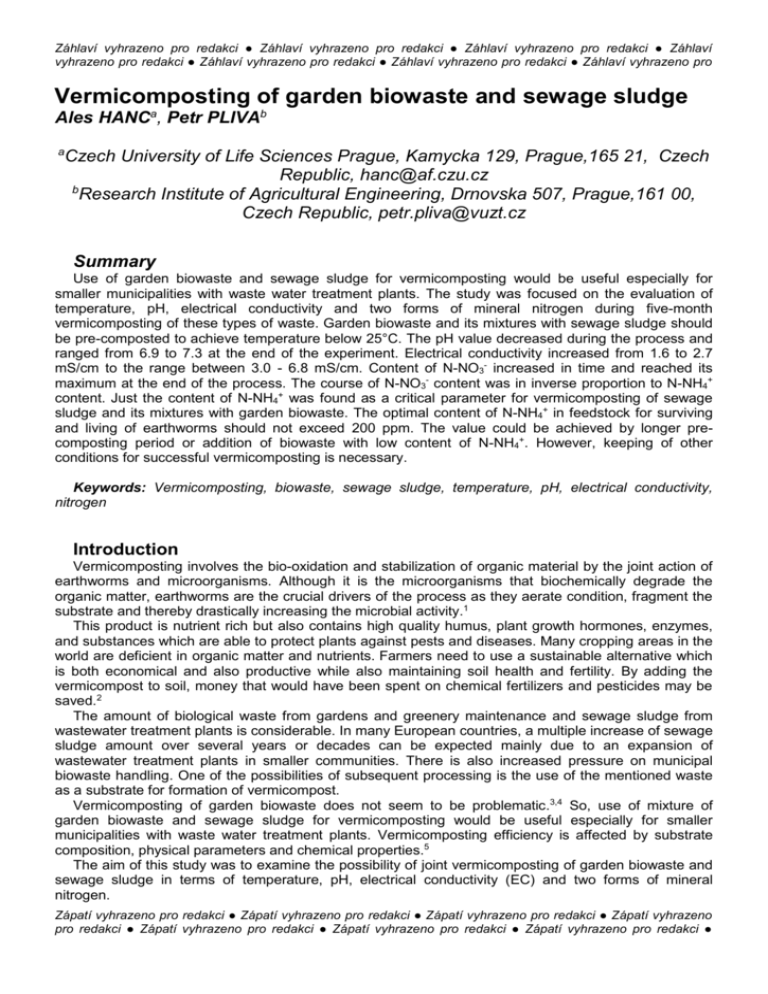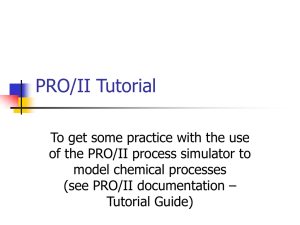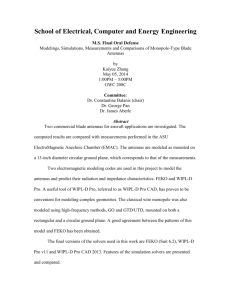Acknowledgment
advertisement

Záhlaví vyhrazeno pro redakci ● Záhlaví vyhrazeno pro redakci ● Záhlaví vyhrazeno pro redakci ● Záhlaví vyhrazeno pro redakci ● Záhlaví vyhrazeno pro redakci ● Záhlaví vyhrazeno pro redakci ● Záhlaví vyhrazeno pro Vermicomposting of garden biowaste and sewage sludge Ales HANCa, Petr PLIVAb a Czech University of Life Sciences Prague, Kamycka 129, Prague,165 21, Czech Republic, hanc@af.czu.cz b Research Institute of Agricultural Engineering, Drnovska 507, Prague,161 00, Czech Republic, petr.pliva@vuzt.cz Summary Use of garden biowaste and sewage sludge for vermicomposting would be useful especially for smaller municipalities with waste water treatment plants. The study was focused on the evaluation of temperature, pH, electrical conductivity and two forms of mineral nitrogen during five-month vermicomposting of these types of waste. Garden biowaste and its mixtures with sewage sludge should be pre-composted to achieve temperature below 25°C. The pH value decreased during the process and ranged from 6.9 to 7.3 at the end of the experiment. Electrical conductivity increased from 1.6 to 2.7 mS/cm to the range between 3.0 - 6.8 mS/cm. Content of N-NO3- increased in time and reached its maximum at the end of the process. The course of N-NO3- content was in inverse proportion to N-NH4+ content. Just the content of N-NH4+ was found as a critical parameter for vermicomposting of sewage sludge and its mixtures with garden biowaste. The optimal content of N-NH4+ in feedstock for surviving and living of earthworms should not exceed 200 ppm. The value could be achieved by longer precomposting period or addition of biowaste with low content of N-NH4+. However, keeping of other conditions for successful vermicomposting is necessary. Keywords: Vermicomposting, biowaste, sewage sludge, temperature, pH, electrical conductivity, nitrogen Introduction Vermicomposting involves the bio-oxidation and stabilization of organic material by the joint action of earthworms and microorganisms. Although it is the microorganisms that biochemically degrade the organic matter, earthworms are the crucial drivers of the process as they aerate condition, fragment the substrate and thereby drastically increasing the microbial activity.1 This product is nutrient rich but also contains high quality humus, plant growth hormones, enzymes, and substances which are able to protect plants against pests and diseases. Many cropping areas in the world are deficient in organic matter and nutrients. Farmers need to use a sustainable alternative which is both economical and also productive while also maintaining soil health and fertility. By adding the vermicompost to soil, money that would have been spent on chemical fertilizers and pesticides may be saved.2 The amount of biological waste from gardens and greenery maintenance and sewage sludge from wastewater treatment plants is considerable. In many European countries, a multiple increase of sewage sludge amount over several years or decades can be expected mainly due to an expansion of wastewater treatment plants in smaller communities. There is also increased pressure on municipal biowaste handling. One of the possibilities of subsequent processing is the use of the mentioned waste as a substrate for formation of vermicompost. Vermicomposting of garden biowaste does not seem to be problematic.3,4 So, use of mixture of garden biowaste and sewage sludge for vermicomposting would be useful especially for smaller municipalities with waste water treatment plants. Vermicomposting efficiency is affected by substrate composition, physical parameters and chemical properties.5 The aim of this study was to examine the possibility of joint vermicomposting of garden biowaste and sewage sludge in terms of temperature, pH, electrical conductivity (EC) and two forms of mineral nitrogen. Zápatí vyhrazeno pro redakci ● Zápatí vyhrazeno pro redakci ● Zápatí vyhrazeno pro redakci ● Zápatí vyhrazeno pro redakci ● Zápatí vyhrazeno pro redakci ● Zápatí vyhrazeno pro redakci ● Zápatí vyhrazeno pro redakci ● Záhlaví vyhrazeno pro redakci ● Záhlaví vyhrazeno pro redakci ● Záhlaví vyhrazeno pro redakci ● Záhlaví vyhrazeno pro redakci ● Záhlaví vyhrazeno pro redakci ● Záhlaví vyhrazeno pro redakci ● Záhlaví vyhrazeno pro Materials and methods Garden biowaste and sewage sludge were used in the experiment (Table 1). Individual components of garden biowaste were mixed on the base of composition typical for family houses settlement in spring period when grass, fine branch and rest of soil prevailed.6 Anaerobically stabilized sewage sludge was obtained from city sewage treatment plant. Table 1: Chosen agrochemical parameters of used materials Dry pH/H2O El. Vol. matter conduct. solids % mS/cm % Garden biowaste 46.5 6.5 3.4 87.9 Sewage sludge 35.1 7.8 0.9 49.0 Ntot N-NH4+ N-NO3- Ptot Ktot % 1.8 2.7 ppm 607 1324 ppm 311 6,1 % 0.1 1.8 % 1.2 0.5 Scheme of the experiment is shown in Table 2. Table 2: Scheme of the experiment Treatm. I II III IV V Type of processing Pre-composting and composting without earthworms Pre-composting and vermicomposting Pre-composting and vermicomposting Pre-composting and vermicomposting Vermicomposting only Feedstocks (% by volume) Garden biowaste 50% + sludge 50% Garden biowaste 100% Garden biowaste 50% + sludge 50% Garden biowaste 25% + sludge 75% Sludge 100% Four treatments (I to IV) were pre-composted in laboratory reactors of 70 L capacity, with perforated stokers enhanced by 40 mm thick foam insulation to reduce heat loss. The reactors were kept in a room at 25°C for 14 days. An active aeration device was used to push air through the composted materials from the bottom. The mixtures were batch-wise aerated for 5 min out of each half hour in volume 4 L air min-1. On the basis of our previous experiences, it was found that this aeration level was usually sufficient to achieve the optimal parameters of composting process. Very low aeration levels are insufficient for effective composting, yet on the other hand, increased aeration merely increases cooling of composted material.7 For vermicomposting, specially adapted laboratory with controlled conditions (temperature 22°C, relative humidity 80%, ventilation for 15 minutes every 12 hours) was used. A 13 L of aerobically precomposted material or raw material was manually mixed with 3 L of substrate contained totally 600 pieces of earthworms of genus Eisenia. The mixture was placed into a plastic tray with perforated bottom, equipped with irrigation and temperature measurement (Picture 1). The tray measured 40 x 40 x 18 cm. The covered trays were put into a metal rack. Each treatment was carried out in triplication. Before sampling, the eventual leachate captured in a stainless tray was returned to the vermicomposted material to achieve a closed loop. A sample of 200g from every tray was collected at the beginning of vermicomposting and every month during five months. The earthworms were sorted out. The resulting samples were dried at laboratory temperature and ground. The samples were analyzed in dry matter because of heterogeneity precaution. After 3rd uptake, 3 L of substrate with earthworms (200 pieces per L) was added again into every tray of treatments III to V because earthworms have escaped. Measurements of pH and EC were made on samples mixed with deionized water (1:10 w/v dry basis) by WTW pH 340 i and TESTO 240, respectively. Contents of N-NH4+ and N-NO3- in 1:10 (w/v) 0.01 mol L-1 CaCl2 extracts were measured colorimetrically using the SKALAR SANPLUS SYSTEM®. Total element contents were determined in the digests obtained by pressurized wet-ashing (HNO3 + HCl + HF) with microwave heating Ethos 1 (MLS GmbH, Germany). Concentrations of elements were determined using inductively coupled plasma optical emission spectrometry (ICP-OES, VARIAN VistaPro, Varian, Australia) with axial plasma configuration. Zápatí vyhrazeno pro redakci ● Zápatí vyhrazeno pro redakci ● Zápatí vyhrazeno pro redakci ● Zápatí vyhrazeno pro redakci ● Zápatí vyhrazeno pro redakci ● Zápatí vyhrazeno pro redakci ● Zápatí vyhrazeno pro redakci ● Záhlaví vyhrazeno pro redakci ● Záhlaví vyhrazeno pro redakci ● Záhlaví vyhrazeno pro redakci ● Záhlaví vyhrazeno pro redakci ● Záhlaví vyhrazeno pro redakci ● Záhlaví vyhrazeno pro redakci ● Záhlaví vyhrazeno pro Picture 1: Vermicomposting in plastic trays Results and discussion Temperature is probably the most important factor affecting growth and reproduction of earthworms.8 Figure 1 illustrates that the maximum temperature of 66°C was recorded after three days in treatment II contained garden biowaste only. It was probably caused by composition of one-third of finely chopped grass with high content of nitrogen. This is the reason for good digestion by microorganisms and subsequently heating of used material. Addition of sewage sludge to the mixture had adverse effect on temperature. In the second week of pre-composting the temperature in all treatments stabilized in the range of 37 to 44 ° C. Based on literature and practical experience, the temperature for the development of earthworm populations should not exceed 25°C. The adverse effect of high temperatures on earthworms is not only direct but also indirect, as a high temperature increases the microbial activity in the substrate, which is reflected in increased consumption of oxygen. This phenomenon may negatively affect the survival of earthworms.9 Garden biowaste should be therefore pre-composted under conditions set in this experiment for more than 2 weeks. The advantage of using of well pre-composted material in particular is that it is eliminating the risk of temperature increase during the subsequent vermicomposting, even for a single use of a greater volume of such modified material. Zápatí vyhrazeno pro redakci ● Zápatí vyhrazeno pro redakci ● Zápatí vyhrazeno pro redakci ● Zápatí vyhrazeno pro redakci ● Zápatí vyhrazeno pro redakci ● Zápatí vyhrazeno pro redakci ● Zápatí vyhrazeno pro redakci ● Záhlaví vyhrazeno pro redakci ● Záhlaví vyhrazeno pro redakci ● Záhlaví vyhrazeno pro redakci ● Záhlaví vyhrazeno pro redakci ● Záhlaví vyhrazeno pro redakci ● Záhlaví vyhrazeno pro redakci ● Záhlaví vyhrazeno pro Figure 1: Course of temperature (°C) during pre-composting Figure 2: Change of pH values during vermicomposting Zápatí vyhrazeno pro redakci ● Zápatí vyhrazeno pro redakci ● Zápatí vyhrazeno pro redakci ● Zápatí vyhrazeno pro redakci ● Zápatí vyhrazeno pro redakci ● Zápatí vyhrazeno pro redakci ● Zápatí vyhrazeno pro redakci ● Záhlaví vyhrazeno pro redakci ● Záhlaví vyhrazeno pro redakci ● Záhlaví vyhrazeno pro redakci ● Záhlaví vyhrazeno pro redakci ● Záhlaví vyhrazeno pro redakci ● Záhlaví vyhrazeno pro redakci ● Záhlaví vyhrazeno pro It is evident from Figure 2 that the pH decreased during the vermicomposting process. The pH value ranged from 6.9 to 7.3 at the end of the experiment. The lowest value was measured at the treatment IV and V with 75% and 100% of sewage sludge, respectively. The highest pH value was measured in treatment II, which contained garden biowaste only. Similarly, in the experiment with vermicomposting of agro-industrial waste, the pH values were in the range 8.2 - 8.9 at the beginning of the process. The values decreased on 7.0 - 7.6 at the end. It could be explained by formation of CO2, NO3- and organic acids.10, 11 Decrease in pH can prevent the volatilization of nitrogen as NH3.12 Earthworms are very sensitive to salt content (salinity or electrical conductivity (EC)) in the substrate and prefer the content to 0.5%.13 Resistance of earthworms to salinity is also dependent on the pH value. Earthworms are tolerant to the values of about 15 mS/cm at pH 6 to 8.14 Figure 3 illustrates an increase of EC during vermicomposting. It increased from 1.6 to 2.7 mS/cm to the range between 3.0 6.8 mS/cm. Similarly in another experiment with vermicomposting of precomposted primary sewage sludge, EC increased from the range 5.7 - 6.6 mS/cm to 6.7 - 8.5 mS/cm.15 The increase could be explained by release of bounded elements during digestion in earthworms.16 In our experiment, the leachate captured in stainless tray was returned to the vermicomposted material to achieve a closed loop. It could cause an increase of EC as well. Since the EC of the substrate is affected by organic matter content, this increase may be due to loss of volatile solids during vermicomposting. The lowest content of EC during vermicomposting was recorded at treatment II (garden biowaste only) with the highest content of volatile solids among treatments. Increased proportion of sewage sludge in mixture resulted in higher EC. Figure 3: Change of EC (mS/cm) during vermicomposting Zápatí vyhrazeno pro redakci ● Zápatí vyhrazeno pro redakci ● Zápatí vyhrazeno pro redakci ● Zápatí vyhrazeno pro redakci ● Zápatí vyhrazeno pro redakci ● Zápatí vyhrazeno pro redakci ● Zápatí vyhrazeno pro redakci ● Záhlaví vyhrazeno pro redakci ● Záhlaví vyhrazeno pro redakci ● Záhlaví vyhrazeno pro redakci ● Záhlaví vyhrazeno pro redakci ● Záhlaví vyhrazeno pro redakci ● Záhlaví vyhrazeno pro redakci ● Záhlaví vyhrazeno pro The contents of ammonium nitrogen ranged in the treatments with sewage sludge from 1300 to 2000 ppm at the start of vermicomposting, which was 5 to 8 times more than in the biowaste garden treatment (Figure 4). Such high levels of N-NH4+ was the reason of death or abandonment of earthworms this material. In another experiment, which dealt with the influence of various factors on the activity and survival of earthworms in aqueous solution, it was found that at pH 7.0 and low concentrations of ammonium nitrogen (0 - 5 mol/L) earthworms survived to 900 hours. At concentrations above 25 mol/L earthworms could survive a maximum of 100 hours.14 In our experiment, the content of N-NH4+ declined during the process. After 1st, 2nd, 3rd, 4th and 5th month, it dropped in the treatments with sludge to 46%, 12%, 6%, 5% and 3% respectively, compared to beginning of vermicomposting. The number of earthworms was inversely proportional to content of N-NH4+. The correlation coefficient R was following for treatment II, III, IV and V: -0.31, -0.67, -0.73 and -0.75, respectively. The found data showed that earthworms were able to survive in material with ammonium nitrogen content less than 200 ppm. Figure 4: Course of N-NH4+ (ppm) during vermicomposting As shown in Figure 5, majority of ammonium nitrogen nitrified during vermicomposting. Content of NNO3- increased in time and reached its maximum at the end of the process. It was mostly directly dependent on increased proportion of sewage sludge in mixture. Evidently, the addition of substrate after 2 months slightly decreased the content of this form of nitrogen in vermicomposted material. Zápatí vyhrazeno pro redakci ● Zápatí vyhrazeno pro redakci ● Zápatí vyhrazeno pro redakci ● Zápatí vyhrazeno pro redakci ● Zápatí vyhrazeno pro redakci ● Zápatí vyhrazeno pro redakci ● Zápatí vyhrazeno pro redakci ● Záhlaví vyhrazeno pro redakci ● Záhlaví vyhrazeno pro redakci ● Záhlaví vyhrazeno pro redakci ● Záhlaví vyhrazeno pro redakci ● Záhlaví vyhrazeno pro redakci ● Záhlaví vyhrazeno pro redakci ● Záhlaví vyhrazeno pro Figure 5: Course of N-NO3- (ppm) during vermicomposting Conclusion Joint vermicomposting of garden biowaste and sewage sludge is possible. Prerequisite for successful vermicomposting of sewage sludge and its mixtures with garden biowaste is to decrease the content of ammonium nitrogen below 200 ppm. The value could be achieved by longer pre-composting period or addition of biowaste with low content of N-NH4+. However, keeping of other conditions for successful vermicomposting is necessary. Acknowledgment Financial support for these investigations was provided by NAZV project No. QI91C199 of the Ministry of Agriculture of the Czech Republic. References 1. Domínguez J., Edwards C.A., Subler S.: BioCycle 38, 57 (1997). 2. Sinha R.K., Agarwal S., Chauhan K, Valani D.: Agr. Sci. 1, 76 (2010). 3. Edwards C.A.: Earthworm Ecology (Edwards, C.A., ed.). St. Lucie Press, Boca Raton, USA, 1998. 4. Sindal R. K., Valani D., Chauhan K., Agarwal S.: (2010): J. Agri. Biotechnol. Sustain. Dev. 2, 113 (2010). 5. Nagar K.: The Complete Technology Book On Vermiculture And Vermicompost. National Institute Of Industrial Research, Delhi, India, 2007. 6. Hanc A., Novak P., Dvorak M., Habart J., Svehla P.: Waste Manage. 31, 1450 (2011). 7. Hanc A., Szakova J., Svehla P.: Bioresour.Technol, doi:10.1016/j.biortech.2011.11.053. 8. Gajalakshmi S., Abbasi S.A.: Ind. J.Biotechnol. 3, 486 (2004). Zápatí vyhrazeno pro redakci ● Zápatí vyhrazeno pro redakci ● Zápatí vyhrazeno pro redakci ● Zápatí vyhrazeno pro redakci ● Zápatí vyhrazeno pro redakci ● Zápatí vyhrazeno pro redakci ● Zápatí vyhrazeno pro redakci ● Záhlaví vyhrazeno pro redakci ● Záhlaví vyhrazeno pro redakci ● Záhlaví vyhrazeno pro redakci ● Záhlaví vyhrazeno pro redakci ● Záhlaví vyhrazeno pro redakci ● Záhlaví vyhrazeno pro redakci ● Záhlaví vyhrazeno pro 9. Domínguez J., Edwards C.A.: (2011): Vermiculture Technology (Edwards C.A., Arancon N., Sherman R., eds.), kap. 3. CRC Press, USA, 2011. 10. Suthar S.: Ecol. Engineering 36, 1028 (2010). 11. Albanell E., Plaixats J., Cabrero T.: Biol. Fertil. Soils 6, 266 (1988). 12. Hartensien R., Hartensien, F.: J. Environ. Qual. 10, 377 (1981). 13. Munroe, G.: Manual of On-Farm Vermicomposting and Vermiculture. Organic Agriculture Centre of Canada. Canada, 2007. 14. Nam P.N., Heck A., Clements J.: Overseas Vietnamese and Chemistry and Chemical Technology Conference. Paris. 7.-9.11.2008. 15. Hait S., Tare, V.: Bioresour Technol. 102, 2812 (2011). 16. Garg P., Gupta A., Satya S.: Bioresour. Technol. 97, 391 (2006). Vermikompostování zahradního bioodpadu a čistírenského kalu Aleš HANČa, Petr PLÍVAb aČeská zemědělská univerzita v Praze, Kamýcká 129, Praha, 165 21, hanc@af.czu.cz ústav zemědělské techniky, Drnovská 507, Praha, 161 00,petr.pliva@vuzt.cz bVýzkumný Souhrn Společné vermikompostování zahradního bioodpadu a čistírenských kalů by mohlo najít uplatnění zejména v obcích, které provozují čistírny odpadních vod. Cílem této práce bylo zhodnotit vermikompostování těchto odpadů z hlediska teploty, pH, elektrické vodivosti a obsahů dvou forem minerálního dusíku v průběhu pěti měsíců tohoto procesu. Bylo zjištěno, že je vhodné zahradní bioodpad a jeho směsi s čistírenskými kaly předkompostovat, aby se dosáhlo snížení teploty materiálu pod 25 °C. Hodnoty pH se během vermikompostování snížily a pohybovaly se od 6,9 do 7,3 na konci experimentu. Elektrická vodivost se zvýšila z intervalu 1,6 až 2,7 mS/cm na 3,0 až 6,8 mS/cm. Obsah NNO3- se také zvýšil a dosáhl svého maxima na konci procesu. Obsahy N-NO3- byly nepřímo úměrné obsahům N-NH4+. Právě vysoký obsah N-NH4+ byl kritický pro vermikompostování čistírenských kalů a jeho směsí se zahradním bioodpadem. Obsah N-NH4+ v surovinách by pro přežití a úspěšný rozvoj žížal neměl překročit 200 ppm. Této hodnoty může být dosaženo delší dobou předkompostování nebo přidáním bioodpadů s nízkým obsahem N-NH4+. Samozřejmě je nezbytné dodržet i další podmínky důležité pro úspěšné vermikompostování. Klíčová slova: Vermikompostování, bioodpad, čistírenský kal, teplota, pH, měrná vodivost, dusík Zápatí vyhrazeno pro redakci ● Zápatí vyhrazeno pro redakci ● Zápatí vyhrazeno pro redakci ● Zápatí vyhrazeno pro redakci ● Zápatí vyhrazeno pro redakci ● Zápatí vyhrazeno pro redakci ● Zápatí vyhrazeno pro redakci ●






